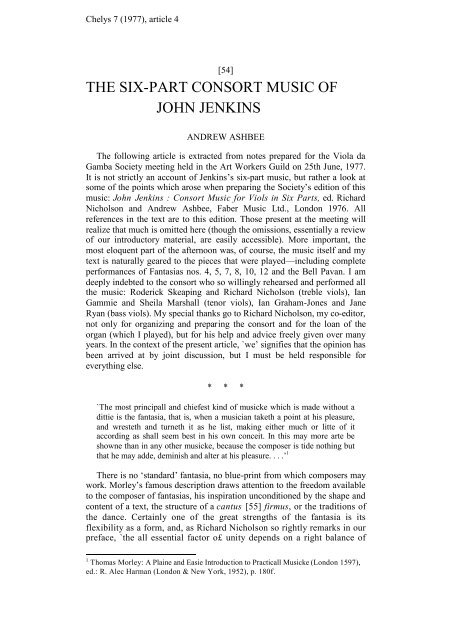download.pdf - 6.3Mb - Viola da Gamba Society
download.pdf - 6.3Mb - Viola da Gamba Society
download.pdf - 6.3Mb - Viola da Gamba Society
Create successful ePaper yourself
Turn your PDF publications into a flip-book with our unique Google optimized e-Paper software.
Chelys 7 (1977), article 4<br />
[54]<br />
THE SIX-PART CONSORT MUSIC OF<br />
JOHN JENKINS<br />
ANDREW ASHBEE<br />
The following article is extracted from notes prepared for the <strong>Viola</strong> <strong>da</strong><br />
<strong>Gamba</strong> <strong>Society</strong> meeting held in the Art Workers Guild on 25th June, 1977.<br />
It is not strictly an account of Jenkins’s six-part music, but rather a look at<br />
some of the points which arose when preparing the <strong>Society</strong>’s edition of this<br />
music: John Jenkins : Consort Music for Viols in Six Parts, ed. Richard<br />
Nicholson and Andrew Ashbee, Faber Music Ltd., London 1976. All<br />
references in the text are to this edition. Those present at the meeting will<br />
realize that much is omitted here (though the omissions, essentially a review<br />
of our introductory material, are easily accessible). More important, the<br />
most eloquent part of the afternoon was, of course, the music itself and my<br />
text is naturally geared to the pieces that were played—including complete<br />
performances of Fantasias nos. 4, 5, 7, 8, 10, 12 and the Bell Pavan. I am<br />
deeply indebted to the consort who so willingly rehearsed and performed all<br />
the music: Roderick Skeaping and Richard Nicholson (treble viols), Ian<br />
Gammie and Sheila Marshall (tenor viols), Ian Graham-Jones and Jane<br />
Ryan (bass viols). My special thanks go to Richard Nicholson, my co-editor,<br />
not only for organizing and preparing the consort and for the loan of the<br />
organ (which I played), but for his help and advice freely given over many<br />
years. In the context of the present article, `we’ signifies that the opinion has<br />
been arrived at by joint discussion, but I must be held responsible for<br />
everything else.<br />
* * *<br />
`The most principall and chiefest kind of musicke which is made without a<br />
dittie is the fantasia, that is, when a musician taketh a point at his pleasure,<br />
and wresteth and turneth it as he list, making either much or litte of it<br />
according as shall seem best in his own conceit. In this may more arte be<br />
showne than in any other musicke, because the composer is tide nothing but<br />
that he may adde, deminish and alter at his pleasure. . . .’ 1<br />
There is no ‘stan<strong>da</strong>rd’ fantasia, no blue-print from which composers may<br />
work. Morley’s famous description draws attention to the freedom available<br />
to the composer of fantasias, his inspiration unconditioned by the shape and<br />
content of a text, the structure of a cantus [55] firmus, or the traditions of<br />
the <strong>da</strong>nce. Certainly one of the great strengths of the fantasia is its<br />
flexibility as a form, and, as Richard Nicholson so rightly remarks in our<br />
preface, `the all essential factor o£ unity depends on a right balance of<br />
1 Thomas Morley: A Plaine and Easie Introduction to Practicall Musicke (London 1597),<br />
ed.: R. Alec Harman (London & New York, 1952), p. 180f.
















